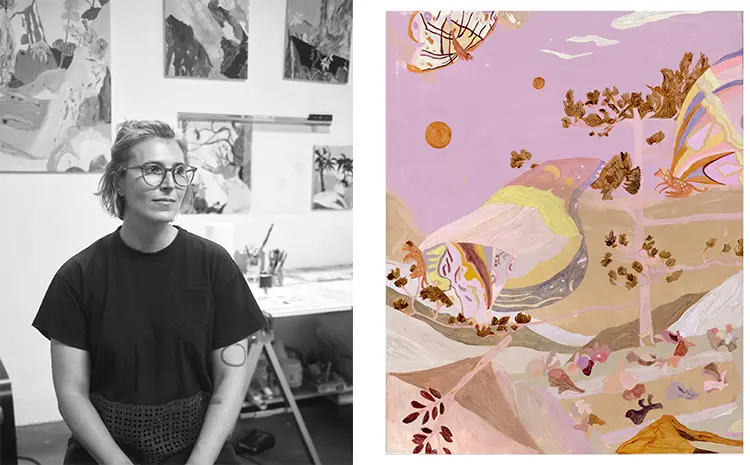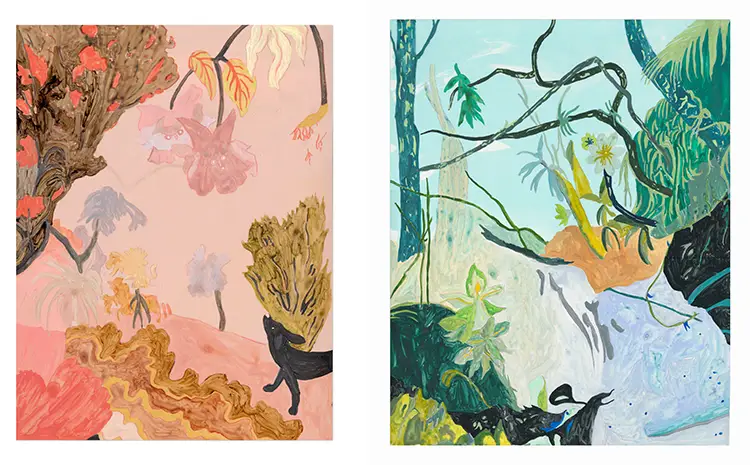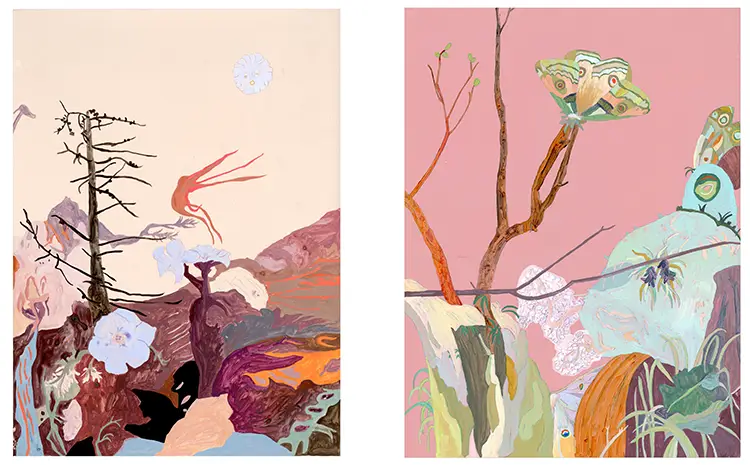“My work explores themes of daydreaming, spirituality, mutation, otherworldly and dimensional vibes… a place uninhabited by humans, but viewed by them.”
Constructed Escapes: A Luminous Journey into Surreal Terrain
Surreal, layered, and rich in otherworldly color, Cary Hulbert’s art constructs enigmatic spaces that pull viewers beyond the recognizable. A New York City–based artist with an MFA from Columbia University, Hulbert fuses her background in printmaking with a vibrant painting practice that navigates themes of mutation, spirituality, and fantasy. Her pieces evoke dreamlike places unbound by logic or gravity, often appearing inhabited by unseen forces yet devoid of human presence. This imagined world becomes a visual sanctuary, not merely a reflection of her creativity, but a channel for expansive, personal storytelling.
Hulbert’s professional journey is steeped in the technical precision of printmaking, a foundation that continues to shape her painted compositions. Her process begins with drawings rendered in colored pencil, a step that anchors each piece before layers of gouache, acrylic, or oil follow. When working on mylar, she adds silkscreened imagery using acrylic ink, infusing her works with a striking luminosity. This interplay of media—drawing, screen printing, and painting—builds an intense depth of light and color, illuminating each piece from within. Though she chooses not to reveal every aspect of her method, the complexity is evident: these aren’t flat representations, but dimensional visual constructions designed to immerse.
What makes Hulbert’s work stand out is the seamless merging of her technical expertise with a playful, untethered imagination. The structure she inherited from years in print-based work has not constrained her; instead, it acts as scaffolding for a painted universe where floating objects, spontaneous transformations, and ambiguous spatial dynamics reign. Viewers are invited into this ambiguous geography, a visual echo of dreams where logic gives way to wonder. Her art asks questions rather than offering answers, and in doing so, it crafts space for contemplation, escape, and visual joy.

Cary Hulbert: Between Print and Paint, the Art of Layered Expression
Hulbert’s transition from traditional printmaking into painting has been far from a departure—rather, it represents a confluence of disciplines that speaks to her depth as a visual artist. Trained extensively in print methods, she has taught the craft at institutions such as Massachusetts College of Art and Design and Columbia University. In her professional life, she continues to work as a Master Etcher in a printshop, contributing to projects for other artists while nurturing her own evolving practice. This daily proximity to the mechanics of printing has embedded in her a sensibility for process, repetition, and visual clarity, which are evident even in her most experimental paintings.
Her art exists in constant dialogue with her training—each painted piece contains an undercurrent of precision, often originating from a disciplined colored pencil drawing. Yet, Hulbert’s approach to paint is far from rigid. Acrylics provide her the immediacy she needs to make the most of limited studio hours, while oils, though slower, lend themselves to her more intricate or contemplative pieces. She selects surfaces according to her intention: quick-drying acrylics find a home on mylar or panel, while oils settle into canvas. These strategic decisions not only reflect her creative rhythms but also address practical concerns such as price points for collectors, bridging the gap between artistic freedom and sustainability.
Her experiments extend beyond the confines of two-dimensional work. During her time in graduate school, Hulbert gravitated toward immersive installations—some kinetic, some powered by Arduino or Raspberry Pi systems that allowed them to light up or move. She has ventured into video art, ceramic sculpture, and 3D animation, proving that her curiosity and willingness to adapt are central to her artistic identity. Regardless of the medium, her signature aesthetic persists: an amalgamation of structural expertise and fantastical intent that transforms physical materials into experiences.

The Space That Watches: Vision, Influence, and Inspiration
At the heart of Hulbert’s creative impulse lies an intrinsic relationship with solitude and reflection. Moving during her early years shaped a need for escape, a search for alternate realities where emotional safety and artistic freedom coexisted. Art became that space. With encouragement from teachers and family, she leaned into her creativity, eventually attending an art school outside Boston. Post-college, she embraced a bartering system, trading artwork for services, while immersing herself in a collective art scene that emphasized visibility, collaboration, and practice. Exhibiting monthly, she operated with a sense of urgency, measuring success by quantity and engagement.
Today, that hustle has evolved into a more focused, deliberate studio practice. Hulbert’s workspace is a zone of complete concentration—free of laptops and digital distractions. Shared with two other artists but rarely crowded, her studio is intentionally sacred, reserved solely for creative output. Podcasts provide a rhythm in the background, allowing her to work without falling into the emotional loops music can induce. Her relationship with productivity is practical: working a full-time job to support her life in New York means that every studio minute is non-negotiable. If the inspiration doesn’t flow, she walks away, trusting the energy will return rather than forcing it.
Influence for Hulbert is more atmospheric than stylistic. She finds resonance in artists who bend or rupture norms—surrealists like Leonora Carrington and outsider visionaries such as Adolf Wölfli, Hilma af Klint, and Henry Darger. Painters like Mamma Andersson, Charles Burchfield, and Peter Doig have also left indelible marks on her. Each shares a devotion to color, texture, and the mystical. Carrington’s Self-Portrait (Inn of the Dawn Horse) remains especially important. On view at the Metropolitan Museum of Art, the painting has served as a compass for Hulbert’s spatial sensibilities, reminding her that compositions need not follow conventional rules—they can whisper, float, and dream.

Cary Hulbert: An Artist Between Dimensions and Disciplines
Hulbert’s paintings aren’t just aesthetic experiences; they offer portals into imagined terrains that balance between familiarity and invention. Her work intentionally sidesteps the human figure, creating environments that feel like they are observed by, but not inhabited by, people. This inversion flips the conventional viewer-art relationship, placing us not as participants, but as guests in landscapes that carry their own logic. Surreal but not alienating, these places speak to transformation—of matter, of space, of thought. The boundaries are porous, and within them, Hulbert finds the freedom to express a vocabulary all her own.
Within her practice lies an unrelenting curiosity about material. Her past explorations in kinetic sculpture and 3D animation suggest a mind that refuses to stay still, always looking for new ways to articulate visual ideas. Even ceramics, which she continues to create in neighborhood studios, reflect a tactile engagement with process. Each discipline she engages becomes another lens through which she refines her central themes. Whether she is screen-printing on mylar or building a kinetic structure, there is consistency in her vision: one that privileges the surreal, the spiritual, and the strangely beautiful.
Looking forward, Hulbert dreams of returning to her roots in printmaking—this time for herself. Her ambition to create multicolored, multi-plate etchings stems from both love and longing. The challenge is time: when one spends days etching for others, staying late for personal projects becomes elusive. To reclaim that space, she’s applying for residencies where she can trade roles—stepping into the position of the visiting artist rather than the technician. It’s a full-circle desire, one that underscores how much her practice is both self-sustaining and in constant evolution.








